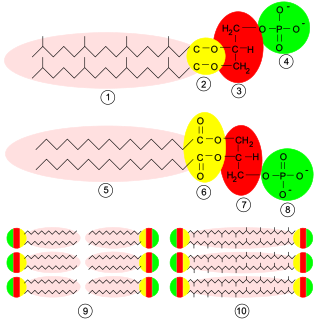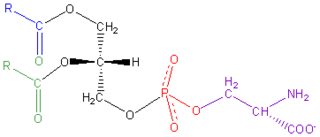
Egg lecithin is a type of lecithin, a group of compounds primarily containing phospholipids, that is derived from eggs.

Egg lecithin is a type of lecithin, a group of compounds primarily containing phospholipids, that is derived from eggs.
Egg lecithin was first isolated in 1846 by the French chemist and pharmacist Theodore Gobley. [1] Gobley originally isolated lecithin from egg yolk —λέκιθος (lekithos) is 'egg yolk' in ancient Greek —and established the complete chemical formula of phosphatidylcholine in 1874.
Phosphatidylcholine a major component of egg lecithin, occurs in all cellular organisms, being one of the important components of the phospholipid portion of the cell membrane. Other components include phosphatidylethanolamine and sphingomyelin.
Egg lecithin is usually extracted chemically using ethanol, acetone, petroleum ether but not benzene or hexane due to restrictions on residual solvents by the pharmaceutical regulations. [2] It is an emulsifier, especially for parenteral use since it does not need to be metabolized. In aqueous solution, its phospholipids can form either liposomes, bilayer sheets, micelles, or lamellar structures, depending on hydration and temperature. This results in a type of surfactant that is usually classified as amphipathic.
Commercial egg lecithin, specified in the United States National Formulatory (USP/NF) as used by pharmaceutical companies, is a highly purified mixture of phospholipids, devoid of triglycerides, cholesterol, or proteins.
Egg lecithin has emulsification and lubricant properties, and is a surfactant. It can be totally integrated into the cell membrane in humans, so does not need to be metabolized and is well tolerated by humans and nontoxic when ingested; some synthetic emulsifiers can only be excreted via the kidneys.
Applications include:
Egg lecithin is approved by the United States Food and Drug Administration with the status "generally recognized as safe" [5] and listed in the compendium.
Egg-derived lecithin is not usually a concern for those allergic to eggs since commercially available food grade egg lecithin is devoid of allergy causing egg proteins. Egg lecithin is not a concern for those on low-cholesterol diets, because the lecithin found in eggs markedly inhibits the absorption of the cholesterol contained in eggs. [6]
An emulsion is a mixture of two or more liquids that are normally immiscible owing to liquid-liquid phase separation. Emulsions are part of a more general class of two-phase systems of matter called colloids. Although the terms colloid and emulsion are sometimes used interchangeably, emulsion should be used when both phases, dispersed and continuous, are liquids. In an emulsion, one liquid is dispersed in the other. Examples of emulsions include vinaigrettes, homogenized milk, liquid biomolecular condensates, and some cutting fluids for metal working.

Phospholipids are a class of lipids whose molecule has a hydrophilic "head" containing a phosphate group and two hydrophobic "tails" derived from fatty acids, joined by an alcohol residue. Marine phospholipids typically have omega-3 fatty acids EPA and DHA integrated as part of the phospholipid molecule. The phosphate group can be modified with simple organic molecules such as choline, ethanolamine or serine.

Surfactants are chemical compounds that decrease the surface tension or interfacial tension between two liquids, a liquid and a gas, or a liquid and a solid. Surfactants may function as emulsifiers, wetting agents, detergents, foaming agents, or dispersants. The word "surfactant" is a blend of surface-active agent, coined c. 1950.

The lipid bilayer is a thin polar membrane made of two layers of lipid molecules. These membranes are flat sheets that form a continuous barrier around all cells. The cell membranes of almost all organisms and many viruses are made of a lipid bilayer, as are the nuclear membrane surrounding the cell nucleus, and membranes of the membrane-bound organelles in the cell. The lipid bilayer is the barrier that keeps ions, proteins and other molecules where they are needed and prevents them from diffusing into areas where they should not be. Lipid bilayers are ideally suited to this role, even though they are only a few nanometers in width, because they are impermeable to most water-soluble (hydrophilic) molecules. Bilayers are particularly impermeable to ions, which allows cells to regulate salt concentrations and pH by transporting ions across their membranes using proteins called ion pumps.

Choline is a cation with the chemical formula [(CH3)3NCH2CH2OH]+. Choline forms various salts, for example choline chloride and choline bitartrate.

Among animals which produce eggs, the yolk is the nutrient-bearing portion of the egg whose primary function is to supply food for the development of the embryo. Some types of egg contain no yolk, for example because they are laid in situations where the food supply is sufficient or because the embryo develops in the parent's body, which supplies the food, usually through a placenta. Reproductive systems in which the mother's body supplies the embryo directly are said to be matrotrophic; those in which the embryo is supplied by yolk are said to be lecithotrophic. In many species, such as all birds, and most reptiles and insects, the yolk takes the form of a special storage organ constructed in the reproductive tract of the mother. In many other animals, especially very small species such as some fish and invertebrates, the yolk material is not in a special organ, but inside the egg cell.

Lecithin is a generic term to designate any group of yellow-brownish fatty substances occurring in animal and plant tissues which are amphiphilic – they attract both water and fatty substances, and are used for smoothing food textures, emulsifying, homogenizing liquid mixtures, and repelling sticking materials.

Phosphatidylcholines (PC) are a class of phospholipids that incorporate choline as a headgroup. They are a major component of biological membranes and can be easily obtained from a variety of readily available sources, such as egg yolk or soybeans, from which they are mechanically or chemically extracted using hexane. They are also a member of the lecithin group of yellow-brownish fatty substances occurring in animal and plant tissues. Dipalmitoyl phosphatidylcholine is a major component of pulmonary surfactant and is often used in the L/S ratio to calculate fetal lung maturity. While phosphatidylcholines are found in all plant and animal cells, they are absent in the membranes of most bacteria, including Escherichia coli. Purified phosphatidylcholine is produced commercially.
Lipophilicity, refers to the ability of a chemical compound to dissolve in fats, oils, lipids, and non-polar solvents such as hexane or toluene. Such non-polar solvents are themselves lipophilic, and the axiom that "like dissolves like" generally holds true. Thus lipophilic substances tend to dissolve in other lipophilic substances, but hydrophilic ("water-loving") substances tend to dissolve in water and other hydrophilic substances.

Glycerophospholipids or phosphoglycerides are glycerol-based phospholipids. They are the main component of biological membranes. Two major classes are known: those for bacteria and eukaryotes and a separate family for archaea.

Pulmonary surfactant is a surface-active complex of phospholipids and proteins formed by type II alveolar cells. The proteins and lipids that make up the surfactant have both hydrophilic and hydrophobic regions. By adsorbing to the air-water interface of alveoli, with hydrophilic head groups in the water and the hydrophobic tails facing towards the air, the main lipid component of surfactant, dipalmitoylphosphatidylcholine (DPPC), reduces surface tension.

An amphiphile, or amphipath, is a chemical compound possessing both hydrophilic and lipophilic (fat-loving) properties. Such a compound is called amphiphilic or amphipathic. Common amphiphilic compound is surfactant, which is a main ingredient of soaps, detergents, and lipoproteins. The phospholipid amphiphiles are the major structural component of cell membranes.

Theodore (Nicolas) Gobley (French: [ɡɔblɛ]; 11 May 1811, in Paris – 1 September 1876, in Bagnères-de-Luchon, was the first to isolate and ultimately determine the chemical structure of lecithin, the first identified and characterized member of the phospholipids class. He was also a pioneer researcher in the study and analysis of the chemical components of brain tissues.

Dipalmitoylphosphatidylcholine (DPPC) is a phospholipid (and a lecithin) consisting of two C16 palmitic acid groups attached to a phosphatidylcholine head-group.

Phosphatidylserine is a phospholipid and is a component of the cell membrane. It plays a key role in cell cycle signaling, specifically in relation to apoptosis. It is a key pathway for viruses to enter cells via apoptotic mimicry. Its exposure on the outer surface of a membrane marks the cell for destruction via apoptosis.

Phosphatidylethanolamine (PE) is a class of phospholipids found in biological membranes. They are synthesized by the addition of cytidine diphosphate-ethanolamine to diglycerides, releasing cytidine monophosphate. S-Adenosyl methionine can subsequently methylate the amine of phosphatidylethanolamines to yield phosphatidylcholines.

The presence of ethanol can lead to the formations of non-lamellar phases also known as non-bilayer phases. Ethanol has been recognized as being an excellent solvent in an aqueous solution for inducing non-lamellar phases in phospholipids. The formation of non-lamellar phases in phospholipids is not completely understood, but it is significant that this amphiphilic molecule is capable of doing so. The formation of non-lamellar phases is significant in biomedical studies which include drug delivery, the transport of polar and non-polar ions using solvents capable of penetrating the biomembrane, increasing the elasticity of the biomembrane when it is being disrupted by unwanted substances and functioning as a channel or transporter of biomaterial.

Lipid nanoparticles (LNPs) are nanoparticles composed of lipids. They are a novel pharmaceutical drug delivery system, and a novel pharmaceutical formulation. LNPs as a drug delivery vehicle were first approved in 2018 for the siRNA drug Onpattro. LNPs became more widely known in late 2020, as some COVID-19 vaccines that use RNA vaccine technology coat the fragile mRNA strands with PEGylated lipid nanoparticles as their delivery vehicle.

Egg oil, also known as egg yolk oil or ovum oil, is derived from the yolk of chicken eggs consisting mainly of triglycerides with traces of lecithin, cholesterol, biotin, xanthophylls lutein and zeaxanthin, and immunoglobulins. It is free of egg proteins and hence may be used safely by people who are allergic to eggs, for topical applications such as hair and skin care. The product has several historical references in Unani (Greek) medicine for hair care. Traditional Chinese medicine uses egg oil for burns, eczema, dermatitis, mouth ulcers, skin ulcers, chapped nipples, tinea capitis, ringworm, nasal vestibulitis, frostbite, and hemorrhoids.
Edible oil refining is a set of processes or treatments necessary to turn vegetable raw oil into edible oil.